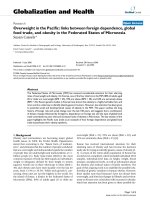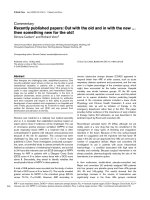Global private banking and wealth management the new realities
Bạn đang xem bản rút gọn của tài liệu. Xem và tải ngay bản đầy đủ của tài liệu tại đây (3.12 MB, 363 trang )
Global Private Banking and
Wealth Management
The New Realities
David Maude
Global Private Banking and
Wealth Management
For other titles in the Wiley Finance Series
please see www.wiley.com/finance
Global Private Banking and
Wealth Management
The New Realities
David Maude
Copyright
C
2006 David Maude.
Published 2006 by
John Wiley & Sons Ltd, The Atrium, Southern Gate, Chichester,
West Sussex PO19 8SQ, England
Telephone
(+44) 1243 779777
Email (for orders and customer service enquiries):
Visit our Home Page on www.wiley.com
All Rights Reserved. No part of this publication may be reproduced, stored in a retrieval system
or transmitted in any form or by any means, electronic, mechanical, photocopying, recording,
scanning or otherwise, except under the terms of the Copyright, Designs and Patents Act 1988
or under the terms of a licence issued by the Copyright Licensing Agency Ltd, 90 Tottenham
Court Road, London W1T 4LP, UK, without the permission in writing of the Publisher.
Requests to the Publisher should be addressed to the Permissions Department, John Wiley &
Sons Ltd, The Atrium, Southern Gate, Chichester, West Sussex PO19 8SQ, England, or emailed
to , or faxed to (+44) 1243 770620.
Designations used by companies to distinguish their products are often claimed as trademarks. All brand
names and product names used in this book are trade names, service marks, trademarks or registered
trademarks of their respective owners. The Publisher is not associated with any product or vendor
mentioned in this book.
This publication is designed to provide accurate and authoritative information in regard to
the subject matter covered. It is sold on the understanding that the Publisher is not engaged
in rendering professional services. If professional advice or other expert assistance is
required, the services of a competent professional should be sought.
Other Wiley Editorial Offices
John Wiley & Sons Inc., 111 River Street, Hoboken, NJ 07030, USA
Jossey-Bass, 989 Market Street, San Francisco, CA 94103-1741, USA
Wiley-VCH Verlag GmbH, Boschstr. 12, D-69469 Weinheim, Germany
John Wiley & Sons Australia Ltd, 42 McDougall Street, Milton, Queensland 4064, Australia
John Wiley & Sons (Asia) Pte Ltd, 2 Clementi Loop #02-01, Jin Xing Distripark, Singapore 129809
John Wiley & Sons Canada Ltd, 22 Worcester Road, Etobicoke, Ontario, Canada M9W 1L1
Wiley also publishes its books in a variety of electronic formats. Some content that appears
in print may not be available in electronic books.
Library of Congress Cataloging-in-Publication Data
Maude, David.
Global private banking and wealth management : the new realities / David Maude.
p. cm.
Includes bibliographical references.
ISBN-13: 978-0-470-85421-1
ISBN-10: 0-470-85421-9
1. Private banks. 2. Banks and banking—Customer services. 3. Wealth—Management. I. Title.
HG1978.M38 2006
332.1 23—dc22
2006005378
British Library Cataloguing in Publication Data
A catalogue record for this book is available from the British Library
ISBN 13: 978-0-470-85421-1 (HB)
ISBN 10: 0-470-85421-9 (HB)
Typeset in 10/12pt Times by TechBooks, New Delhi, India.
Printed and bound in Great Britain by Antony Rowe Ltd, Chippenham, Wiltshire.
This book is printed on acid-free paper responsibly manufactured from sustainable forestry
in which at least two trees are planted for each one used for paper production.
To Francesca and Antonio
Contents
Preface
Acknowledgements
xi
xiii
1 Global Market Overview
1.1 The wealth management market
1.1.1 Investment mandates
1.1.2 Offshore versus onshore
1.1.3 Market size and growth
Box 1.1 Wealth market measurement methodologies: lies, damn lies and
wealth statistics?
1.2 Key wealth drivers
1.2.1 Generic drivers
Box 1.2 US Wealth Dynamics
1.2.2 Regional drivers
1.3 Industry economics
1.3.1 Value drivers and key performance indicators
1.4 Competitive landscape
1.4.1 Industry concentration
1
1
3
4
6
9
13
14
16
20
26
29
35
37
2 Industry Challenges: New and Old
2.1 Clients
2.2 Products, pricing and channels
2.2.1 Products
2.2.2 Pricing
2.2.3 Channels
2.3 Competitors and business models
2.4 External environment
39
40
42
42
43
44
45
47
3 Clients
3.1 Key characteristics
3.1.1 Sophistication
3.1.2 Advice
49
49
49
50
viii
Contents
3.1.3 Buying behaviour
3.1.4 Relationship fragmentation
3.1.5 Regional differences
3.2 Client segmentation
3.2.1 Traditional high-level segmentation: the wealth pyramid
3.2.2 Other segmentation criteria
Box 3.1 Ultra-high net worth individuals
3.2.3 Multiple segmentation criteria
3.2.4 New segments and subsegments
Box 3.2 Client segmentation at Coutts
Box 3.3 Professional sports players
3.3 Client value management
3.3.1 Client acquisition
3.3.2 Client development
3.3.3 Client retention
51
52
53
54
54
55
56
61
62
63
65
67
70
71
72
4 New Products and Pricing
4.1 New products and services
4.1.1 The advisory process
4.1.2 Tracker-related products
4.1.3 Structured products
Box 4.1 Islamic private banking
4.1.4 Alternative investments
Box 4.2 Co-investment
Box 4.3 Structured products and alternative investments – success in
advice-led selling
4.1.5 Property and real estate
Box 4.4 Investment performance measurement
4.1.6 Lending services
4.1.7 Other products and services
4.2 Product sourcing and management
Box 4.5 Multi-manager fund structures
Box 4.6 Product management discipline
4.3 Pricing
Box 4.7 Pricing discipline
77
80
81
84
85
90
92
102
103
105
108
110
112
115
117
121
123
124
5 Distribution Channels
5.1 Relationship managers
5.1.1 Roles
5.1.2 Organisation and structure
5.1.3 Sales effectiveness
Box 5.1 Increasing the time in front of clients
5.1.4 The ‘war for talent’
5.2 Other traditional channels
5.2.1 Referral agents
5.2.2 Branches
5.2.3 Client reporting
127
128
129
132
135
138
140
144
144
145
146
Contents
5.3 New and emerging channels
5.3.1 Online
5.3.2 Broadband and beyond
5.4 Multichannel management
ix
148
149
150
151
6 Players
6.1 Types of players
6.1.1 Private banks
6.1.2 Universal banks
Box 6.1 EFG International
Box 6.2 High-profile retrenchments
6.1.3 Financial advisers
6.1.4 Investment banks
6.1.5 Family offices
Box 6.3 Peer networks
6.1.6 Regional perspective
6.2 Business system upheaval
6.2.1 Value chain disaggregation
6.2.2 Business model convergence
6.2.3 Divestment of non-core businesses
6.3 Consolidation
6.3.1 Recent consolidation activity
Box 6.4 Julius Baer
6.3.2 Consolidation drivers
6.3.3 Best-practice implementation
153
153
153
155
156
159
161
162
163
164
165
168
169
169
171
171
172
176
179
180
7 Operational Excellence
7.1 Smart operational sourcing
7.1.1 Operational outsourcing
Box 7.1 Wealth management insourcing
7.1.2 Operational offshoring
7.2 Lean operations
Box 7.2 Six Sigma
7.2.1 Four lean principles
7.2.2 Benefits
7.2.3 Implementation
7.3 Technology transformation
7.4 Value-added support services
7.5 Instilling operational excellence
7.5.1 Operational redesign
185
187
188
193
194
196
197
199
200
201
202
203
205
205
8 Organisational Design
8.1 Organisational structure
8.2 Business unit interfaces
8.2.1 Asset management
Box 8.1 Citigroup’s asset management exit
8.2.2 Retail bank
209
209
210
212
214
219
x
Contents
8.2.3 Investment bank
8.3 International dimension
222
224
9 Regulatory and Tax Issues
9.1 Money laundering vulnerability
9.2 Regulatory initiatives
9.2.1 Offshore financial centres
9.2.2 USA Patriot Act
Box 9.1 Basle II
9.2.3 Wolfsberg anti-money-laundering principles
9.2.4 Implications of regulatory initiatives for wealth managers
Box 9.2 International accounting standards
Box 9.3 Citigroup Private Bank Japan
Box 9.4 Riggs Bank
9.3 Tax initiatives
9.3.1 OECD project on harmful tax practices
9.3.2 US qualified intermediary regime
9.3.3 European Union Savings Directive
9.3.4 International tax amnesties
9.3.5 Implications of tax initiatives for wealth managers
227
227
230
232
236
236
238
238
239
240
242
246
246
247
248
250
251
10 The Future
10.1 Introduction
10.2 Sources of new profitable growth
10.2.1 New geographies
Box 10.1 Japan
10.2.2 Client relationship deepening
10.2.3 New propositions
Box 10.2 Emerging client segments
10.3 Future industry structure
10.4 Critical success factors
10.5 Conclusions
257
258
259
259
263
267
269
270
274
278
281
Appendices
Appendix 1: Country wealth market analyses
Appendix 2: FATF 40 Recommendations
Appendix 3: FATF special recommendations on terrorist financing
Appendix 4: The Wolfsberg anti-money-laundering principles
283
283
310
318
320
Glossary of Terms
327
Bibliography
333
Index
341
Preface
“Let me tell you about the very rich” (with undisguised envy). “They’re very different from you
and me.”
F. Scott Fitzgerald
“Yes” (taking a long pull from a thick Havana and pausing longer for dramatic effect). “They have
more money.”1
Ernest Hemingway
It is easy to forget that only a few years ago, wealth management was the darling of the financial
services industry. Highly profitable and growing rapidly, everyone wanted a piece of the action.
Indeed, come 1999, it was difficult to find a bank of any stripe that was not targeting the wealth
management business.
Driven by strong global economic growth and buoyant financial markets during the go-go
years of the 1980s and 1990s, wealth managers were able to prosper simply by showing up,
being there and standing relatively still. There was no great need to have a clear strategy or
distinctive client proposition. In many cases, the assets – and profits – just flowed in.
So, what happened? The financial market turmoil of 2000–2002 left many wealth managers –
old and new – highly exposed: exposed more than ever to the global equity market; and, in
the case of the large number of integrated players, exposed, too, to accusations of inherent
conflicts of interest. As Warren Buffet famously said, “It’s only when the tide goes out that you
learn who’s been swimming naked.”2 In short, for many players, at least for a while, wealth
management lost its golden lustre.
Today, with the recovery in financial markets, many players are refocusing on wealth management, and growth initiatives are firmly back on management agendas. The industry’s profile
has never been higher (see Figure 0.1).
Going forward, however, financial markets alone cannot be relied on to grow or even sustain
profits. Many wealth managers’ strategies are in flux and the pace of change is picking up.
New initiatives are appearing by the week.
The main aim of this book is to help wealth management players chart a course through
the new, increasingly choppy, waters. I aim to provide a flavour of the key issues at stake,
1
Conversation anecdotally reported to have taken place in a Paris caf´e in the 1920s. In fact, Fitzgerald wrote the first phrases in
a 1926 short story, ‘The Rich Boy’, and Hemingway replied a decade later in an article, ‘The Snows of Kilimanjaro’, published in
Esquire. (And Hemingway’s glib retort was borrowed from Mary Colum, an Irish literary critic.)
2
Source: Berkshire Hathaway Inc., Chairman’s Letter to Shareholders, 1992.
xii
Preface
Number of press articles* including given term
Thousands
33.0
28.0
25.3
22.6
2 3 .2
1 8 .9
16.0
1 7 .3
1 4 .6
10.3
6.8
“Wealth Management”
“Private Banking”
5.1
4 .0
2 .0
3.8
0.6
1 .2
2 .6
3 .2
3 .9
4 .8
1996
97
98
99
2.8
0.2
8 .7
8 .0
8 .0
9 .8
7 .3
9 .1
6 .3
2000
01
02
03
04
05
* English language only
Figure 0.1 The rise and rise of wealth management
Source: Factiva; author’s analysis.
but the book certainly does not attempt to cover every possible aspect of wealth management. Along route, I hope to blow away some of the myths that have grown up around the
industry.
The good news is that, looking ahead, the industry’s intrinsic fundamentals are relatively
solid. There are still fortunes to be made in wealth management. But one thing is clear: the
private banking and wealth management business will not get any easier to manage.
David Maude
Verona, May 2006
david
Acknowledgements
This book was originally conceived back in 2002, but has taken far longer to bring to fruition
than I originally intended. The sheer weight of client work over this period has been the main
culprit. I therefore thank Philip Molyneux, Professor of Banking and Finance at the University
of Wales, for stepping in to help write several chapters. Anna Omarini, Assistant Professor at
Bocconi University, also kindly assisted with one of the chapters.
Several people helped out by reviewing draft chapters, including Helen Avery at Euromoney,
Marc Kitten at Candesic and Sascha Schmidt at a-connect.
Various executives at the leading players provided insightful discussions and helped refine
my thinking. Similarly, many clients, knowingly or unknowingly, have provided input over the
years. However, all examples in the text are either drawn from public information or, where
based on my professional experience, have been disguised to protect client confidentiality.
Special thanks go to Christian Casal, John Cheetham, Andrew Doman, Hugh Harper,
Francesca Rizzi, Purnima Roy, Corrado Ruffini, Frederic Vandenberghe, Martha Whitmore
and other former colleagues at McKinsey & Company, who provided extensive comments and
source material.
I am also very grateful to a number of other people who generously devoted time and source
material, including: Christian de Juniac, Boston Consulting Group; Ian Woodhouse, IBM
Business Consulting Services; Bruce Weatherill, PricewaterhouseCoopers; Stephen Jarvis,
Alberto Pagliarini and Huw van Steenis, Morgan Stanley; Liz Nesvold and Jennifer Sransky,
Berkshire Capital; Gavin Houlgate, KPMG; Alan Gemes, Booz Allen Hamilton; Lauren Taylor,
Mercer Oliver Wyman; Dominic Wilson, Goldman Sachs; Marc Rubinstein, Credit Suisse;
Javier Lodeiro, Bank Sarasin; Jon Diat, Citigroup; Carolin Deutsch and Dana Grosser, SEI;
Anne Bourgeois, Datamonitor; Karen Cohen, Renee Duvall, Petrina Dolby, Ronni Edens and
Donie Lohan, Capgemini; Sierk Nawijn, ABN AMRO; Jon Peace, Fox-Pitt, Kelton; Conrad
Ford and James Morris, Barclays; Christian Kwek, BNP Paribas; Matt Spick, Deutsche Bank;
Daniel Davies, Exane BNP Paribas; Christopher Humphrey, Eden McCallum; Dr Bernhard
Koye, Swiss Banking School, University of Zurich; and Richard Drew.
I also thank Sam Hartley, Emily Pears and Viv Wickham at John Wiley & Sons, Ltd, who
kept me on the straight and narrow, and ensured that the publication process ran smoothly.
This book could not have been written without the love and support of my family. Extra
special thanks go to my wife, Francesca, and to my son, Antonio, who had to put up with his
Dad typing away for long hours instead of playing with him.
Needless to say, any errors in the text are mine alone.
DJM
1
Global Market Overview
In the late 1990s, wealth management was reported to be the fastest growing sector of the
financial services industry. Though the 2000–2002 downturn took its toll on many wealth
management providers, looking ahead, the industry remains attractive, with strong fundamentals. Globally, the number of millionaires continues to grow at more than 7% a year – around 6
times the pace of the population as a whole.1 The industry is certainly up there with investment
banking in terms of fun, glamour and glitz. However, to meet the evolving needs of clients,
the industry has become increasingly broad and complex.
For decades, the industry was dominated by a select group of sleepy, very traditional players.
But during the 1990s, the industry changed almost beyond recognition. There was a huge influx
of new players offering a wide range of specialised products and services to a broader, ever
more demanding client base.
The aims of this introductory chapter are to:
r Define the wealth management market and provide an idea of its size and recent growth.
r Examine the key drivers of the wealth management industry.
r Outline the economics of the industry.
r Briefly describe the competitive landscape.
Most of the themes introduced here will be explored in more detail in later chapters.
1.1 THE WEALTH MANAGEMENT MARKET
There is no generally accepted standard definition of wealth management – both in terms of
the products and services provided and the constitution of the client base served – but a basic
definition would be financial services provided to wealthy clients, mainly individuals and their
families.
Private banking forms an important, more exclusive, subset of wealth management. At
least until recently, it largely consisted of banking services (deposit taking and payments),
discretionary asset management, brokerage, limited tax advisory services and some basic
concierge-type services, offered by a single designated relationship manager. On the whole,
many clients trusted their private banking relationship manager to ‘get on with it’, and took a
largely passive approach to financial decision making.
Private banking has a very long pedigree, stretching back at least as far as the seventeeth
century in the case of some British private banks.2 It is, however, only really over the last
15 years or so that the term ‘wealth management’ has found its way into common industry
parlance. It developed in response to the arrival of mass affluence during the latter part of
1
The compound annual growth rate (CAGR) in the global number of millionaires, 2002–2004, is 7.4% (source: Capgemini/Merrill
Lynch). The CAGR in the global population, 2000–2005, is 1.2% (source: Population Division of the Department of Economic and
Social Affairs of the United Nations Secretariat, 2004).
2
See Maude and Molyneux (1996), Chapter 1, for a discussion of private banking origins and historical evolution.
2
Global Private Banking and Wealth Management
the twentieth century; more sophisticated client needs throughout the wealth spectrum; a
desire among some clients to be more actively involved in the management of their money;
a willingness on the part of some types of financial services players, such as retail banks
and brokerages, to extend their offerings to meet the new demand; and, more generally, a
recognition among providers that, for many clients, conventional mass-market retail financial
services are inadequate. Wealth management is therefore a broader area of financial services
than private banking in two main ways:
r Product range. As in private banking, asset management services are at the heart of the wealth
management industry. But wealth management is more than asset management. It focuses
on both sides of the client’s balance sheet. Wealth management has a greater emphasis on
financial advice and is concerned with gathering, maintaining, preserving, enhancing and
transferring wealth. It includes the following types of products and services:
(a) Brokerage.
(b) Core banking-type products, such as current accounts, time deposits and liquidity management.
(c) Lending products, such as margin lending, credit cards, mortgages and private jet
finance.
(d) Insurance and protection products, such as property and health insurance, life assurance
and pensions.
(e) Asset management in its broadest sense: discretionary and advisory, financial and nonfinancial assets (such as real estate, commodities, wine and art), conventional, structured
and alternative investments.
(f) Advice in all shapes and forms: asset allocation, wealth structuring, tax and trusts,
various types of planning (financial, inheritance, pensions, philanthropic), family-dispute
arbitration – even psychotherapy to children suffering from ‘affluenza’.
(g) A wide range of concierge-type services, including yacht broking, art storage, real estate
location, and hotel, restaurant and theatre booking.
Based on research by BCG, non-cash investments may account for no more than c.36% of
the global wealth management revenue pool (see Figure 1.1).
r Client segments. Private banking targets only the very wealthiest clients or high net worth
individuals (HNWIs): broadly speaking, those with more than around $1 million in investable
assets. Wealth management, by contrast, targets clients with assets as low as $100 000, i.e.
affluent as well as high net worth (HNW) clients.
Robert J. McCann, President of the Private Client Group at Merrill Lynch, provided a
succinct definition of wealth management at a recent industry conference:
[Wealth management] addresses every aspect of a client’s financial life in a consultative and a
highly individualised way. It uses a complete range of products, services and strategies. A wealth
manager has to gather information both financial and personal to create an individualised series of
recommendations, and be able to make those recommendations completely tailored to each client.
Off the shelf – it won’t do. What [wealth management] requires is connecting with clients on a
personal level that is way beyond the [retail financial services] industry norm.
When asked to describe the factors that distinguish their services from other types of retail
financial institution, wealth managers emphasise the uniqueness of their client relationships –
relationships that are broad, in that they encompass all areas of a client’s financial life, and deep
Global Market Overview
2003
Percent
3
100% = c.$200 bn–$250 bn
Insurance
14
36
Investments**
Lending
20
30
Deposits
*From households with AuM > $100,000
**Including managed funds and directly held securities
Figure 1.1 Wealth management revenue pool* by product
Source: Boston Consulting Group; author’s calculations.
with respect to the advisor’s intimate knowledge of a client’s values and priorities. In turn, this
breadth and depth of relationship enables the wealth manager to develop and implement highly
tailored solutions that address all aspects of a client’s financial well-being. At a minimum, the
following three criteria differentiate a firm as a wealth manager:
r The relationship that wealth managers have with their clients, both in terms of breadth
r
r
(where providers emphasise terms such as ‘holistic’, ‘comprehensive’ and ‘all-inclusive’)
and depth (‘intimate’ and ‘individualised’).
The products and services provided, with a particular emphasis on estate planning and multigenerational planning services, as well as tax advisory expertise and alternative investments.
The specific objectives of wealthy clients, such as investment performance, wealth preservation or wealth transfer.
1.1.1 Investment mandates
Wealth managers may serve clients under different types of investment mandate. At the most
basic level, the wealth manager may act as a pure custodian for a client’s assets. That involves, essentially, asset safekeeping, income collection, fund disbursement and associated
reporting.
Under an execution-only mandate, the wealth manager executes, or selects brokers to execute, securities transactions on behalf of the client. The wealth manager does not provide investment advice, so this service is aimed primarily at self-directed clients. The wealth manager
4
Global Private Banking and Wealth Management
is typically required to seek ‘best execution’ for client transactions, i.e. executing transactions
so that the client’s total cost, or proceeds, in each transaction is as favourable as possible to
the client under the particular circumstances at that time.
The next level of investment mandate is a formal service-level contract, of which there are
two types:
r Advisory mandate, under which the wealth manager will discuss and advise the client on
r
investment opportunities. The client then makes the buying and selling decisions based on a
combination of his or her own ideas and the investment advice of the wealth manager. The
wealth manager will not make any investment decision without the client’s prior approval.
The wealth manager is generally paid a commission based on the volume of executed trades,
plus custody fees.
Discretionary mandate, under which the wealth manager usually has sole authority to buy
and sell assets and execute transactions for the benefit of the client, in addition to providing
investment advice. Discretionary management works by starting off with the construction
of a brief with the client, detailing investment aims, level of risk-aversion and other factors
that will influence the portfolio. In some discretionary accounts, the wealth manager is given
only limited investment authority. However, in all cases, major investment decisions, such
as changing the account’s investment strategy or asset allocation guidelines, may be subject
to the client’s approval. The wealth manager is generally paid on the basis of a flat-fee
arrangement linked to the value of the assets under management. The gross revenue margin
of a discretionary mandate is typically at least double that of an execution-only mandate.
The proportion of clients using advisory mandates is, in general, relatively stable across
the various client wealth bands. Execution-only mandates become more prevalent, and discretionary mandates less prevalent, as client wealth rises. That typically reflects a greater degree
of financial sophistication among the wealthier clients.
Wealth management can mean different things in different geographic regions. The US and
Europe have traditionally stood at two extremes in this regard. In the US, wealth management is
more closely allied to transaction-driven brokerage and is typically investment-product driven.
In Europe, the term is more synonymous with traditional private banking, with its greater
emphasis on advice and exclusivity.
1.1.2 Offshore versus onshore
A fundamental distinction within wealth management is onshore versus offshore. Onshore
wealth management is the provision of products and services within the client’s main country
of residence. Offshore wealth management, by contrast, serves clients wishing to manage their
wealth outside their main country of residence for reasons such as: financial confidentiality;
legal-system flexibility; tax considerations; the lack of appropriate products and services onshore; a low level of trust in domestic financial markets and governments; and the need for
safety and geographical diversification in response to domestic political and macroeconomic
risks. Indeed, some clients treat their offshore account(s) primarily as a ‘vault’.
Some practitioners go further and refer to four types of wealth management. Take the example of a Swiss wealth manager. It will, of course, have a presence in Switzerland: its domestic
business. Its domestic business will typically serve two types of clients. First, there are Swiss
clients seeking to keep assets within their own country of residence, which is referred to as the
Global Market Overview
5
Importance of bank attributes* for given types of bank
%
70
Trustworthy
and reliable
Brand//
reputation
Professional
Offshore
Confidentiality
Innovative
35
Forward looking
Helpful
Performance
Sincere/honest
Keep promise
Approachable/
easy to deal with
Flexible
Consistent
Transparent
0
0
Caring//
attentive
Accessible//
conveniently
located
branches
Proactive
Relationships
Easy to use
35
70
Onshore
*Multiple answers possible
Figure 1.2 Wealth manager attributes
Source: McKinsey & Company, ‘Annual Investment and Wealth Management CEO Conference, 2005’. Reproduced
by permission.
wealth manager’s domestic onshore business. Its domestic business may also serve clients from
outside Switzerland, which is referred to as the wealth manager’s domestic offshore business.
The Swiss wealth manager may also have a presence outside Switzerland: its international
business. That may include a presence in Italy, serving both Italian clients (i.e. its international
onshore business) and non-Italian clients (i.e. its international offshore business).
The onshore/offshore distinction matters because these two types of wealth management
have very different client appeal, dynamics, product sets and economics (see below). Figure 1.2
illustrates that offshore private banks need, in particular, strong brands, trustworthiness and a
high degree of professionalism. For onshore private banks, there is greater emphasis on local
branch presence, strong relationships and ‘user friendliness’.
As Figure 1.3 illustrates, the proportion of wealth managed offshore varies significantly
across regions. There is a general trend for assets to shift onshore, particularly in Western
Europe, which is primarily driven by a series of global tax initiatives (see Chapter 9). But that
shift is happening at different speeds, and some regions – including Africa, the Middle East,
Latin America and Eastern Europe – continue to have a sizeable offshore wealth component.
At the client level, the proportion of wealth held offshore tends to rise in line with the level of
wealth. In terms of offshore wealth destinations, the main offshore centres are Switzerland, the
United Kingdom (including the UK Channel Islands – Jersey, Guernsey and Isle of Man), Hong
Kong, Singapore, Luxembourg, Gibraltar, Monaco, Cayman Islands, the Bahamas, New York
6
Global Private Banking and Wealth Management
ESTIMATE
Percentage of total wealth from given region
75
Africa
70
Middle East
65
E.Europe
55
Latin America
30
Asia excl. Japan
25
W.Europe
Japan
3
N.America
3
Global average* = 23%
*Weighted by wealth
Figure 1.3 Wealth held offshore
Source: Boston Consulting Group; Julius Baer; author’s client work.
and Miami. There are different types of offshore centres. Some – such as London, New York
and Miami – offer a comprehensive range of private banking services in their own right. Others,
such as the Cayman Islands, are principally booking centres, where funds and transactions are
registered.
1.1.3 Market size and growth
Primary questions for wealth managers the world over is: who are the wealthy and how much
wealth do they have?
Measuring the size of the wealth management market is certainly no easy task. For a start,
as noted above, there is no generally accepted market definition. Individual institutions differ
widely both in the level of the wealth threshold they use to separate a wealth management
‘client’ from a mass-market ‘customer’, and in how they define wealth itself. Frequently used
metrics include: annual gross income, liquid financial assets, investable assets, net worth (i.e.
assets net of debt) or some combination of these. The thresholds are sometimes defined by the
geographic market that the wealth management provider is targeting.
The wealth management market is probably best thought of as a group of distinct submarkets,
based on client wealth bands. Again, institutions vary considerably in how they define these
wealth bands and in how they label them (see Figure 1.4). Broadly, the market can be divided
into two subgroups – affluent and high net worth – with, in turn, further subsegmentation within
each.3
3
Note that the focus here is on defining the overall market. Chapter 3 provides a more detailed discussion of client segmentation
practices at the more granular level.
Global Market Overview
• Definition: financial assets, often liquid (e.g. excludes property)
• Benefits: useful for middle aged people or older
• Limitations: does not reveal complete financial profile if sizeable portion of assets derived from business/partnership
Investable asset
definitions
Investable assets
Institution/source
0
$25,000
100,000
200,000
250,000
300,000
500,00
US institution
3 MM 5 MM
1 MM
Affluent
HNW
10 MM
50 MM
VHNW
UHNW
Emerging affluent
Emerging affluent**
US private client survey*
US retail bank
Mass affluent
Affluent
HNW
VHNW
Upscale affluent
Global institution
HNW
Mass affluent
HNW
Capgemini/Merrill Lynch WorldWealthReport
HNW
UHNW
Credit Suisse
VIP Forum
Decamillionaire
Income definitions
• Definition: annual gross household income
• Benefits: useful for targeting young potential customers (i.e. the “nouveau riche”)
• Limitations: not meaningful for elderly, inheritance recipients and big spenders
Household income
Institution/source
0
75,000
100,000
125,000
150,000
175,000
200,000
225,000
250,000
European universal bank
Mendelsohn Affluent Survey
Net
Net worth
worth
definitions
definitions
• Definition:Assets–Liabilities or
(Financial Assets + Non-financial Assets)–Debts
• Benefits: useful for the very rich and those with sizeable interests in a business/partnership
• Limitations: not useful for the young
Net worth
Institution/source
0
250,000
500,000
1M
5M
• Coutts
50M
HNW
• J.P. Morgan Chase/ Goldman Sachs
• Spectrem Group
HNW
Affluent***
HNW †
Pentamillionaire††
* Income must be >$100 K; affluent+ people must be between age 30-70; investable assets are defined as assets including 401K and retirement assets; but
excludes primary home
** Age 21-44
*** Affluent defined as either >$100K in income or >$500 K in net worth (not including property)
† HNW defined on basis of investable assets, not net worth
†† Not including property
Note: Not drawn to scale
Figure 1.4 What is wealthy? Client indicative wealth threshold definitions
Source: Author’s analysis.
7
8
Global Private Banking and Wealth Management
EXAMPLES OF DIFFERENT ENTRY CRITERIA APPLIED BY PRIVATE BANKS
Example 1
• Minimum account size USD 1m
Example 2
• USD 5m+of bankable assets
Example 3
•
•
•
•
Example 4
• Decision of relationship manager based on
assessment of client's financial potential
Example 5
• Minimum USD 0.2m with minimum advisory
management services
• Minimum USD 0.5m in discretionary
management with limits on investment
possibilities
• Minimum USD 1m in discretionary
management without limits
Minimum account size USD 0.5m or
Use of derivative products or
Use of discretionary mandate or
Language requirements
Figure 1.4 (Continued)
There is no industry-wide minimum requirement for the bankable assets entry criterion. In
any case, the minimum account size often reflects the bank’s aspiration rather than reality (even
at the most upscale institutions, the average account size is usually below the minimum asset
requirement). During the late 1990s, many banks moved down market and accepted clients who
did not fulfil their communicated entry criteria. Also, at the industry level, entry thresholds do
not tend to change much over time and have not generally kept pace with asset-price inflation:
over the long term, real (i.e. inflation-adjusted) entry thresholds for many players have fallen.
There are generally no official government or private statistics on the actual distribution of
wealth within individual countries. We are therefore forced to rely on estimates, which come
in a variety of shapes and forms (see Box 1.1).
Micro, survey data are often unreliable. Not unnaturally, many individuals deliberately
attempt to conceal the exact size of their wealth, and a large proportion of wealth may be held not
only in secret accounts and trusts but also in assets that are illiquid and/or not publicly quoted.
Furthermore, it is often difficult to draw a distinction between an entrepreneur’s corporate and
personal wealth.
Hence, in using these data, a ‘health warning’ applies: clearly, the output, in terms of the
wealth estimate, can only ever be as good as the input, in terms of the data and analysis on
which the estimate is based; the final estimates will be highly sensitive to the assumptions made;
and there can, therefore, be substantial differences in estimates from different organisations.
For example, Capgemini/Merrill Lynch estimate that global HNWI wealth as at end-2004
was $30.8 trillion; the corresponding estimate from The Boston Consulting Group was $24.5
trillion; and UBS’s published internal estimate4 was $35.4 trillion. There are also substantial
differences within the regional breakdowns and dynamics (see Figure 1.5).
Box 1.1 explores some of the reasons for these differences and examines wealth marketsizing methodologies more generally.
4
Source: Presentation by Peter Wuffli, CEO, UBS, at Morgan Stanley European Banks conference, 22 March 2006, page 8.
Estimate excludes real estate, private business interests, insurance and other illiquid assets.









